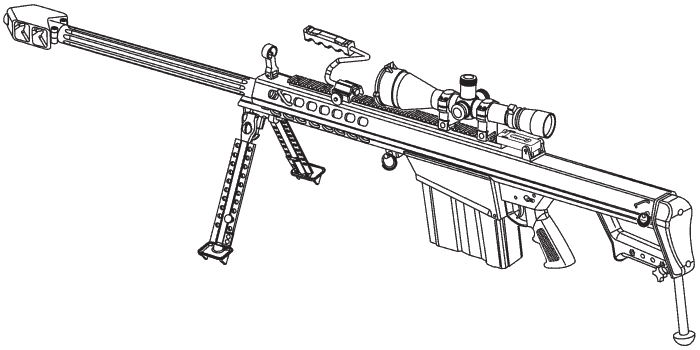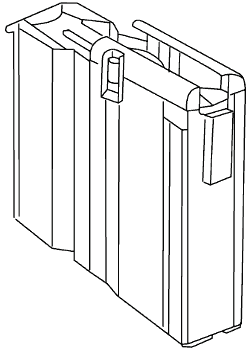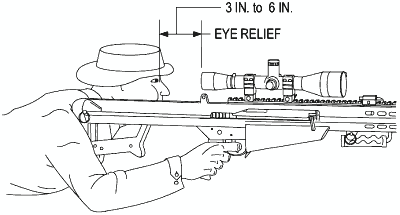| TECHNICAL DATA |
|---|
| | M107 |
|---|
| Alternative Designations | Semi-Automatic Long Range Sniper Rifle, Semi-Automatic Anti-Material Rifle, USMC Special Applications Scoped Rifle (SASR), Heavy Sniper Rifle (HSR) |
|---|
| Country of Origin | USA |
|---|
| Date Of Introduction | 2002 |
|---|
| Caliber | 0.50 in (12.7 mm) |
|---|
| Cartridge | .50 Browning Machine Gun (12.7 x 99 mm) |
|---|
| System of Operation | Short recoil |
|---|
| Weight, Gun and Scope, Unloaded | 28.5 lb (12.9 kg) |
|---|
| Length | Assembled: 57 in (1,448 mm)
Takedown Mode: 38 in (965 mm) |
|---|
| Barrel Length | 29 in (737 mm) |
|---|
| Barrel Rifling | R.H., eight lands and grooves, pitch 1 in 15 inches (381 mm) |
|---|
| Safety Features | Manual thumb-lever |
|---|
| Trigger Pull | ? |
|---|
| Magazine Capacity | 10 rounds.
The preferred load is 8 to 9 rounds. |
|---|
| Weight Magazine | 10 rounds: 4.12 lb (1.87 kg)
8 rounds: 3.62 lb (1.64 kg) |
|---|
| Performance (with standard 660 grain bullet) |
|---|
| Muzzle Velocity | 2,800 fps (853 mps) |
|---|
| Muzzle Energy | 11,500 foot-pounds (15,582 J) |
|---|
| Maximum Range | 7,450 yd (6,812 m) |
|---|
| Maximum Effective Range | 2,000 yd (1,829 m) |
|---|
| Sights |
|---|
| Front Sight | Flip-up 0.075 in. (1.91 mm) post with a protective, anti-glare ring |
|---|
| Rear Sight | Flip-up peep, adjustable for windage and elevation |
|---|
| Daylight Scope |
|---|
| Type | Leupold 4.5x14 Vary X |
|---|
| Length | 12.63 in (320.80 mm) |
|---|
| Reticle | Mil dot |
|---|
| Lens | 1.97 in (50 mm) |
|---|
| Elevation | 1 click equals 1/4 MOA (Minutes of Angle) at 328 ft (100 meters) |
|---|
| Windage | 1 click equals 1/4 MOA at 328 ft (100 meters) |
|---|
| Eye Relief | 3 to 6 in (76 to 152 mm) |
|---|
DESCRIPTION
The M107 Long Range Sniper Rifle (LRSR) is a .50 caliber rifle with attached optics/electro-optics that supports all weather,
day/night tactical dominance via rapid-fire direct fire engagements with armor penetrating, incendiary, dual-purpose ammunition.
The M107 is based on the Marine Corps M82A3 Special Application Scoped Rifle.
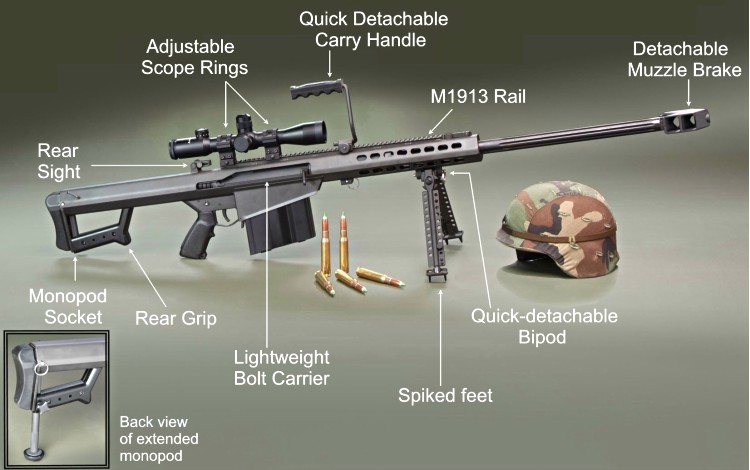
Click for larger 1652x1048, 328K image.
The M107 provides a man-portable, materiel destruction capability to the sniper team and/or supported force and complements the
anti-personnel precision fire capability of the M24 Sniper Weapon System (SWS). The M107, with a family of ammunition, enables
sniper teams to employ greater destructive force at greater ranges and at a higher rate of fire that exceed the terminal effect
capability of the M24 (7.62mm, bolt action) SWS.
The primary mission of this rifle is to engage and defeat materiel targets at extended ranges to include parked aircraft; command,
control, communications, computers, and intelligence (C4I) sites; radar sites; ammunition; petroleum, oil and lubricants; and various
other thin skinned (lightly armored) materiel targets out to 2000 meters.
The M107 will also be used in a counter sniper role taking advantage of the longer stand off range and increased terminal effect
when opposing snipers armed with smaller caliber weapons out to 1000 meters.
The M107 is a semi-automatic, air-cooled, box magazine-fed rifle chambered for .50 caliber ammunition.
This rifle operates by means of the short recoil principle, rather than gas.
The basic M107 rifle is equipped with bipod, muzzle brake, carrying handle, and 10-round removable magazine. The M107 system is
composed of the rifle and a sniper scope, plus six spare magazines. The rifle is also supplied with a fitted dirt-tight and watertight
carrying case, the requisite cleaning kit drag bag, cleaning equipment, and the telescope adjustment tools.
The M107 will replace existing non-standard, M82A1, caliber .50 rifles in Explosive Ordnance Detachments as detonation tools.
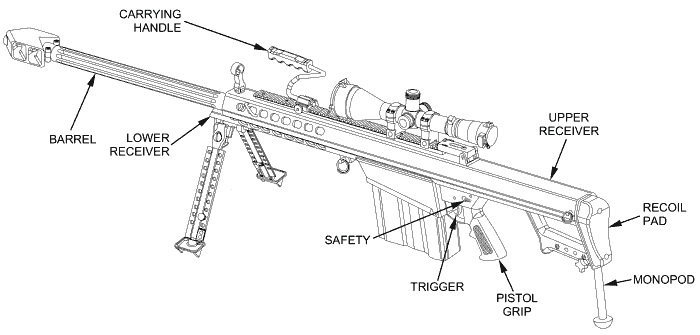
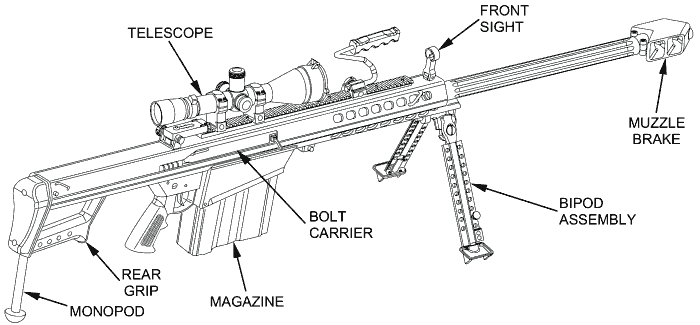
Daylight Scope
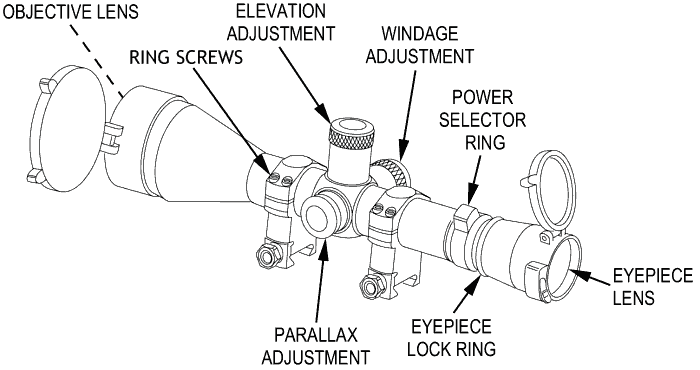
There are seven basic parts to the daylight scope: the object lens (front lens), the elevation adjustment turret,
the windage adjustment turret, the power selector ring, the eyepiece lock ring, the eyepiece lens, and the parallax
adjustment turret (left side).
Unless there is something wrong with the telescope, it will not be removed for normal field stripping.
Iron Sights
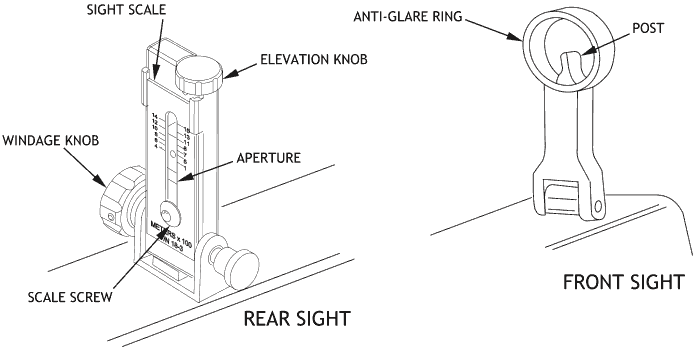
The front and rear iron sights are primarily to be used for emergency back-up when the optical sights are not available.
They flip up for use if the telescope is not mounted.
Aiming is accomplished by aligning the target with the aperture of the rear sight and the post of the front sight. The front
sight post is protected from damage by the anti-glare ring.
The rear sight aperture is raised and lowered to the desired elevation position using the elevation knob. The windage knob is
used to adjust for proper windage. A rear sight elevation scale has been established that corresponds to the ballistics of the
cartridge and is adjustable to accommodate variations in environmental conditions that affect elevation.
Setting the position of the rear sight elevation scale is best done at a range of 500 meters to give the optimum position for both
ball and high explosive ammunition.
HISTORY
Contractor: Barrett Firearms Mfg.
Type Classification Date: TC STD 4Q FY 2002.
Prior to Type Classification, permission to procure the M107 Sniper Rifle was based on Urgent Materiel Release approval for overseas operations.
M107 Procurement. FY 2005 Budget Estimate.
|
FY 2001 |
FY 2002 |
FY 2003 |
FY 2004 |
FY 2005 |
|---|
| Quantity |
48 |
150 |
600 |
600 |
600 |
|---|
| Gross Cost |
$500,000 |
$2,100,000 |
$9,000,000 |
$8,700,000 |
$8,900,000 |
|---|
| Unit Cost |
$10,417 |
$14,000 |
$15,000 |
$14,500 |
$14,833 |
|---|
In support of Operation Iraqi Freedom (OIF) and Operation Enduring Freedom (OEF), additional items are being procured as part of
the Rapid Fielding Initiative (RFI). The RFI provides new equipment (Laser Filter Units, Spotter Scopes and ancillary items) to
units deployed.
Approved for full materiel release to soldiers in the field in 2005.
OPERATION
The cycle of operation for the M107 Rifle is broken down into eight basic steps (more than one step may occur at the same time).
- Feeding: The force of the mainspring pushes the bolt forward toward the barrel extension, stripping a cartridge from
the magazine and loading it into the chamber (by hand when first loading, by semiautomatic action afterwards).
- Chambering: The bolt forces the round fully into the firing chamber, and the extractor snaps over the case rim.
Blockages (dirt or debris) can prevent full chambering, as can dirty, bent, dented, or otherwise faulty ammunition.
- Locking: During chambering the bolt enters the barrel extension, and the bolt latch engages the bolt latch trip
(inside top of the upper receiver, just behind barrel extension). The bolt latch is then depressed, allowing the bolt to retract
into the bolt carrier. The bolt, in turn, rotates due to the cam slot and is locked when its three locking lugs rotate into place
in the barrel extension, closing the firing chamber.
- Firing: Pulling the trigger pivots it on the trigger housing pin and presses on the transfer bar, causing the bar to
rise. The transfer bar engages the sear (housed in the bolt carrier), forcing it upward and out of engagement with the firing pin
extension. The firing pin extension, under spring power, forces the firing pin forward to strike the primer of the cartridge.
- Unlocking: When the cartridge is fired, gas pressure exerts a thrust on the bolt face via the case head. The bolt
carrier carries the bolt and barrel extension to the rear until the accelerator, protruding beneath the bolt carrier, contacts a
shoulder in the trigger housing area. The accelerator is then pivoted up, causing the accelerator rod to be pushed out of the bolt
carrier. As it protrudes from the front of the bolt carrier, it separates the bolt carrier from the barrel extension. Because of
the cam slot in the side of the bolt, the bolt rotates as it is pulled and unlocks from the barrel extension.
- Cocking: As the bolt recoils to the rear, the cocking lever "rides" the transfer bar back and down, causing it
to disconnect from the trigger. The transfer bar is then held down in this position by the disconnector and is not released until
pressure is released from the trigger. After disconnection, the cocking lever swings on its pin and overrides the transfer bar.
The other end of the cocking lever protrudes into the bolt carrier and into the firing pin extension. As the cocking lever pivots,
it withdraws the firing pin and compresses the firing pin extension spring. The firing pin extension then catches the sear.
- Extraction: As the bolt locking lugs rotate away from the barrel extension, the bolt withdraws from the barrel and the
bolt latch locks the bolt in its extended position. The extractor, located on the bolt face and hooked over the rim of the fired
case, pulls the case from the firing chamber.
- Ejection: As soon as the fired case has been extracted and has cleared the rear of the barrel extension, it is expelled
from the rifle by the spring-powered ejector.
WARNING: The bolt does NOT automatically remain to the rear when the rifle or magazine is empty.
VARIANTS
- XM107
-
- M107 (NSN 1005-01-469-2133)
-
2002. Standard production model. See data above.
AMMUNITION
The magazine has a ten round capacity. The preferred load is 8 to 9 rounds. Load no more than 9 rounds or damage will occur.
- MK211 Mod 0, Caliber .50 API Cartridge
- M33, Caliber .50 Ball Cartridge
- M17, Caliber .50 Tracer Cartridge
- M8, Caliber .50 API Cartridge
- M20, Caliber .50 APIT Cartridge
- M1A1, Caliber .50 Blank Cartridge
Click here for more information on .50 caliber ammunition.
Use of unauthorized ammunition in the M107 Sniper Rifle can cause personal injury or damage to rifle.
The .50 caliber saboted light armor penetrator (SLAP) round is specifically prohibited from being fired in the M107. Forcing it to
chamber and fire may cause serious injury to personnel and damage to the rifle.
Ammunition that predates 1965 should not be fired through this weapon.
FIRING
This weapon generates harmful levels of noise when firing! Hearing protection must be worn when firing this weapon.
If the scope is mounted too far to the rear, the eyepiece can injure the shooter's brow. Shooting at an uphill angle also increases
this hazard.
With the M107 rifle, there is some danger in standing to the side of the muzzle due to blow-by of hot, expanding gasses from the muzzle brake.
This rifle must not be fired without the muzzle brake firmly in place on the barrel because the action can thus be overstressed,
and critical parts breakage can occur.
Because the rifle is recoil-operated, the shooter must be positioned squarely behind the weapon, with the recoil pad firmly against
the shoulder. Anything less may result in injury, discomfort, or failure of the action to cycle correctly.
The rifle will fire one round for each squeeze of the trigger until the magazine and chamber are empty.
Remember that the bolt does NOT automatically remain to the rear when the rifle or magazine is empty.
The rear and front iron sights are primarily to be used for emergency back-up when the optical sights are not available. They flip
up for use if the telescope is not mounted.
More M107 Art - Click on image sample to see full size image.
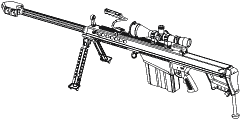
1024x509, 29K, GIF
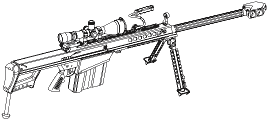
1024x455, 26K, GIF
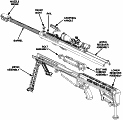
1024x1000, 41K, GIF
M107 Photos - Click on image sample to see full size image.
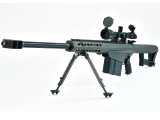
M107
U.S. Army PEO Soldier Photo
1024x768, 433K, JPEG
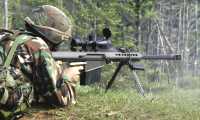
M107
U.S. Army PEO Soldier Photo
930x540, 127K, JPEG
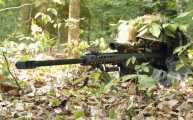
M107
U.S. Army PEO Soldier Photo
1024x638, 217K, JPEG
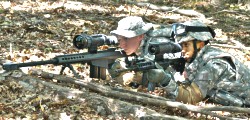
M107 with AN/PAS-13 Thermal Weapon Sight (TWS)
U.S. Army PEO Soldier Photo
1024x681, 254K, JPEG
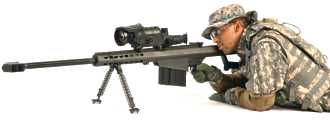
M107 with AN/PVS-10 Sniper Night Sight (SNS)
U.S. Army PEO Soldier Photo
1024x330, 61K, JPEG
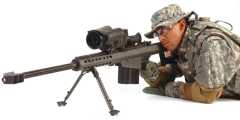
M107 with AN/PVS-10 SNS
U.S. Army PEO Soldier Photo
1024x500, 78K, JPEG
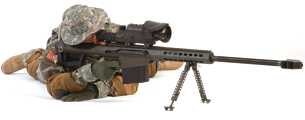
M107 with AN/PVS-10 SNS
U.S. Army PEO Soldier Photo
1024x400, 55K, JPEG
